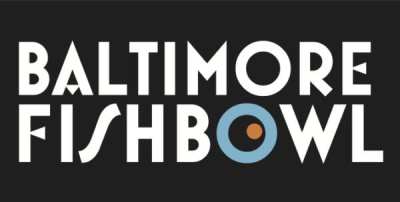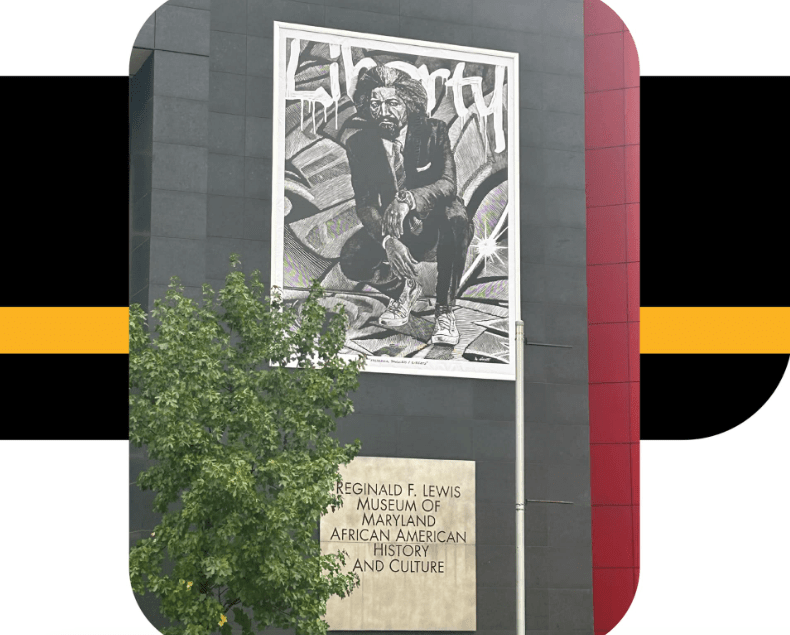It would be hard to miss the thoughtful and sober gaze of Maryland’s own Frederick Douglass if one was driving down East Pratt Street past the Reginald F. Lewis Museum of Maryland African American History and Culture. The 21-foot-high banner, striking clothing choice, contemporary pose, and the word “LIBERTY” splashed behind him makes certain of that.
Douglass was born into slavery in 1818 as Frederick Augustus Washington Baily in Talbot County, Maryland. At the age of 20, he escaped to New York City and eventually landed in Massachusetts. He became a living legend for his advocacy for the abolition of slavery and civil rights, including women’s suffrage in the 19th century. He was the closest African American advisor to President Abraham Lincoln.
The museum’s board chair had been to the shore, and told Terri Lee Freeman, president of the museum about a rendering of Douglass he’d seen on a banner* in Talbot County. He showed Freeman a picture of it, and amazed, she took the board to see it. One of the board members is a descendant of Douglass and incorporated great history lessons into the trip. During the trip, Richard Marks, the philanthropist who purchased the piece for Dock Street Foundation, told Freeman that he’d purchased more than one and offered to give one to the Reginald F. Lewis Museum.
“My thing about the Lewis Museum is always to encourage people to think, to always have people figure out why you have a perspective either way,” Freeman said. “But have a perspective think about things. …[T]he board was in agreement, and the staff was really excited about the perspective of having the banner as well, because we felt that it would be a real good conversation starter.”
Several facets of the piece spark conversation. Douglass’s face is universally recognizable, as he was the most photographed man of his time, and his face on the banner is the one most are accustomed to seeing. What draws attention are his pose and his dress: crouched down in a casual, yet still commanding pose; dressed in contemporary and stylish clothing. He’s wearing a slim-fitting pinstriped suit with a white shirt and tie, Converse Chuck Taylor All-Star sneakers, and a large watch. Splashed behind him in spray-painted white lettering is the word “Liberty.”
“Knowing how fastidious he was about his appearance?” Freeman began, “I think that this would have fit him to a ‘T’. He also had an affinity for young people, and so he wanted young people to take up the cause.”
Freeman likened Douglass to Martin Luther King, Jr. in that they both began to feel less relevant as they got older, but still tried to reach young people with their messages. She thought it completely plausible that Douglass, who always kept up with the latest fashion when he lived, would be in the latest fashion of today if he were here now.
She said she has not received any pushback about the portrayal of Douglass as a contemporary figure in a setting from today, but it has sparked conversation, which is the intention, after all. Nor has she yet gotten negative feedback on the fact that the artist, Adam Himoff, is white.
“I stepped back from it and thought to myself, ‘But this is an artistic rendering,’” Freeman recalled. “And you know what? I didn’t have any negative connotation to it either.” She supposes some might have “feelings” when they realize Himoff is white, but she doesn’t think that changes how they would view the rendering.
“Adam’s rendering certainly was not to be pejorative,” Freeman said.
Himoff, a Utah-based artist was born in New York City. His artistic training and education were “largely self-directed and included classes at The Art Students League of New York, Rhode Island School of Design, and Dartmouth College, where he graduated cum laude in 1998 with a BA in English Literature and significant coursework in Studio Art,” according to his bio. After working for several decades in business and finance, Himoff was motivated during the COVID-19 shutdown to transition to a life of full-time artmaking.
After learning so much about Douglass’s life experience and writings in college, Himoff regarded him as an extraordinarily powerful icon, and the concept of icons has become core to his artwork.
He engaged in what he described as a massive research process that portraying such an icon entails, which with Douglass was a fascinating journey for him. Himoff eventually completed “Frederick Douglass/Liberty,” a hand-carved linocut print, in 2021 in the isolation of the COVID shutdown, editioning 40 prints of the original piece.
“I felt real power around the character of Frederick Douglass,” Himoff told Fishbowl. “I am also fascinated with the notion around style and the filter of cool and … that we have this expectation that our heroes should be like Barack Obama in a stylish suit.” It brought him to the question of how to bring Frederick Douglass into the present. How does he create that pathway?
“[N]ot long after I put it out into the world, a representative, a woman representing the ACLU, reached out and said that, you know, she wanted to buy one for their headquarters in New York,” Himoff told Fishbowl. That had a huge impact on him, and as word of the banner grew, a philanthropist in Easton, Maryland reached out to buy several for the Historic Society. He was very excited by the concept of his work being displayed in a place with such a close connection with Douglass himself. Next, though, the person reaching out asked if it could be turned into a mural.
“[I was] blown away by the concept and sort of skeptical that something like that could even happen,” Himoff remembered. “The prospect of this image turning into a mural was beyond words, and very exciting.” It was installed in Easton last November.
He described some pushback about the anachronistic nature of depicting Douglass in modern-day clothing and stance, mostly from articles he’d read in the Washington Post and NPR. Some, including descendants of Frederick Douglass’s brother who lived in Easton, were not pleased with the modernization. They wanted him to be left static in his imagery from when he lived. Overwhelmingly, though, Himoff has received thousands of positive comments and reactions.
“I think for me, it really clarified just the importance of the conversation and having discussions, and promoting these discussions, and having that be part of what the intent is of the artwork,” Himoff said.
Freeman expects the Reginald F. Lewis Museum to have programming surrounding the artwork. While not yet fully planned, it may include a conversation with the artist, a Frederick Douglass scholar, and/or a conversation between the two. The museum is excited about thinking of how they might utilize the banner in interesting and innovative ways to engage the citizens of Baltimore.
The Reginald F. Lewis Museum of Maryland African American History and Culture is located at 830 E. Pratt St., Baltimore, MD. Its hours are Monday, Thursday – Saturday: 10 a.m. to 5 p.m.; Sunday: noon to 5 p.m. Ticket prices range from free to $12.
*(“Frederick Douglass/Liberty” is often described as a mural, but it is really a banner, as it is affixed to, rather than painted on the side of the building.)


